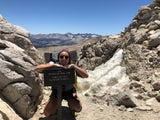How to use trekking poles

Trekking poles are simple to use and provide a load of support for both hikers, walkers and backpackers of all ages. Whether you're crossing flat surfaces or probing uncertain terrain, trekking poles can provide stability and relieve pressure from your body, but they can also help to establish and maintain a consistent rhythm and increase speed.
If you're anything like our team members at Cascade Mountain Tech, you're probably aiming to continue hiking well into your old age. Trekking poles can help to reduce impact over time and prolong your body's capabilities. For first time users, trekking poles may not be as intuitive as one might hope. Check out our video and helpful guide below to get you started off on the right foot!
Trekking Pole Length
All of Cascade Mountain Tech's trekking poles are height adjustable. Before you begin your journey, make sure to extend or shorten your poles to the proper height. While holding the grip of your pole, your arm should bend at a 90-degree angle while the tip is on the ground and your elbow is at your side.
Use the inch or centimeter markers on your poles to help remember where you find the most comfortable height position.
Using our quick lock poles you will see inch and centimeter markings on the bottom and middle section of each pole. If the middle section is fully extended to the 52 inch mark and the top section is fully extended to the 52 inch mark the entire pole height is 52 inches.
Using our folding poles you can extend the top section the the 54 inch mark. The pole is now 54 inches in length.
When hiking uphill, shortening each pole by 5-10cm will provide more leverage and help your ascent. When traversing downhill, lengthening the pole 5-10cm will provide the ideal support to slow your descent and help save your knees, ankles and legs over the long run. Overall, you should always adjust to what feels best to you for your support needs.
Securing Your Pole Locks
Whether you're using our Quick-Lock or Twist-Lock trekking poles, make sure that your locks are firmly secured before using your poles. While the tip is on the ground, test to ensure the lock is secure by pushing on the top of the handle so the tip presses into the ground. If your pole shortens while doing this then you need to readjust the height and tighten the lock more.

Swing Cadence
There's no one right way to hike with trekking poles, though most will argue that trekking asymmetrically does the most to help propel you forward on steep ground (left pole comes forward as the right foot comes forward, and vice versa). While some hikers prefer this standard method, others find it more comfortable to swing both arms at the same time. We find that swinging your poles the same way you would swing your arms without poles is the best bet for each user.
Pole Positioning
When hiking uphill, position your poles at roughly a 70-degree angle (in the direction that you're heading), rather than straight up and down, helping to propel you forward. When hiking back downhill, you can place your hands on top of the grips and reverse the angle, using the poles to provide better stability and relieve pressure on your legs. Try spreading your arms further apart during descents for even greater stability.

Handle Grips & Wrist Straps
Each trekking pole grip is fitted with our padded adjustable wrist straps, which are easy to adjust to fit large and small hands alike. Our poles are meant to be held like ski poles – to correctly grasp the grip, reach through the wrist strap from underneath the strap and grasp the handle. The strap should be positioned in between your thumb and index finger when grasping the pole, and should catch on your wrist when the pole is dropped. Correctly using the wrist straps allows you to use poles without using a death grip all throughout your hike, and will also prevent you from dislocating or breaking your thumb if you were to fall while holding your poles.
Tip Accessories
Each Cascade Mountain Tech trekking pole is built with a tungsten carbide tip, meant to provide optimal grip on a variety of surfaces, including rocks, dirt or ice. Our included accessories are meant to be used on varying surfaces. Screw on the mud baskets when hiking through sand or mud. Try the snow baskets when traveling through loose or compact snow (NOTE: our poles are not meant for alpine or nordic skiing). Our rubber boots are great for crossing large boulders, for extended downhill treks, or for added stability on level ground. The round rubber boots, which are attached to each pole in packaging, are helpful to protect interior floors or to use when hiking through places like Machu Pichu that aim to preserve the quality of its trails.

Head to our trekking pole collection page to view our entire offering of poles and to find product videos on each type. For even more support, check out our video page for helpful info on adjusting your wrist straps and on our various trekking pole accessories. See you on the trail!





Comments
George said:
Where do you explain the markings and numbers on the poles?
Mary Eastman said:
Hiked at Big Bend, no poles. Sore knees and hips. Bought a pair of your Trekking Poles and have had them with me when hiking in Scotland for 3 weeks. Living in New Mexico gives me many opportunities to hike and your poles are the top on my list. Share them with friends who now use trekkers and we all love the assurance and comfort they give. Thanks, many walks and hikes, past , present and future.
Tom Egan said:
In the instruction paper I got you it says your website will show how to use the the accessories – tip and baskets. The instructions are also not clear on the instillation of them on the pole. I checked the website and did not find anything that would help me. Anything you could do to assist in the would be appreciated. Perhaps a video. Thank you. Tom Egan
Cascade Mountain Tech said:
Hi Tom,
Thanks for reaching out. We have some resources on our trekking poles which you might find helpful which you can view here: https://cascademountaintech.com/pages/trekking-pole-information
That being said, if you would like for us to walk you through tips and tricks on how to install the baskets and tips, please call us at 855-873-5765 and we would be more than happy to help!
Bob Raibert said:
I have a new set of carbon fiber trekking poles. The anti-shock on one pole works great, the second one(new) will not back off the 1/4 turn to activate the shock. What tricks are there to get this working?
Cascade Mountain Tech said:
Hi Bob,
Thanks for reaching out. Sorry to hear you are having issues with your trekking poles. I would urge you to contact our customer support team who will be able to help you with this issue. You can contact them here: https://cascademountaintech.com/pages/contact
Best,
Cascade Mountain Tech
Roy Parker said:
Great poles but I wore out the tips. Bought new ones but cannot determine how to replace the existing tips. Help.
Thank you,
Roy
Cascade Mountain Tech said:
Hi Roy Parker, our Customer Service team will reach out to you for help. If you bought a replacement lower you should simply be able to unlock the original lower section, pull it out and then insert the new lower section and lock into place.
Kevin Morgano said:
I do most my hiking in heavily wooded rough terrain near Mammoth Cave in KY. I use a wizzard length hiking stick and take my time, keeping an eye out for snakes and critters and a dog or three.
How are hiking sticks at moving branches and knocking down spider webs? Sometimes I have a machete in my free hand.
Quinn Ford said:
Love the poles. Got them as a present. Can’t wait to use them. Not sure how to use that little figure eight clip. I’m assuming it goes on the bottom to hold the poles together and then wrap the straps around the grips?
Cascade Mountain Tech said:
Hi Quinn Ford,
Are you referring to this piece: https://cascademountaintech.com/collections/trekking-pole-parts-locks/products/trekking-pole-parts-trekking-pole-clip-replacement
If so, this is used to help hold together both of the poles while in storage. Hope this helps!
Best,
Olivia
Eric B. said:
PROPER STRAP USE:
Use the straps as pictured above. Pole straps are not just for “attaching them to your wrist”. They are mainly used for PUSHING AGAINST in a downward motion. Watch good cross country skiers and you will see them using their pole straps this way.
This method helps take the strain off your fore arm muscles and gives stability while hiking downhill.
DETAILS: 1.)→ tighten pole straps so your hand can grip the handle high enough.
2.)→ FOR COMFORT try to re-arrange your pole straps so the bottom strap is exiting the handle is where your thumb is. Yep, there are LEFT and RIGHT pole strap configurations and using them this way makes it more comfortable for your hands.
jerry slack said:
how to adjust the strap? Is it necessary to pull the pin so the doesn’t strap doesn’t have trist in it?